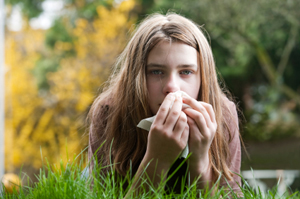All about Grass Pollen Allergy
Grass pollen is said to cause a lot of allergic reactions. Grass pollen in the air affects many people. In late springs and in the early months of the summer season, this causes allergic conditions resulting in rhinitis, asthma, and conjunctivitis. Any contact of skin with the grass or any kind of sitting in the grass or actions like mowing the lawn etc causes a lot of itching sensation in the skin. So atopic dermatitis and urticaria result after a normal grass allergy. Grass pollen allergy is also said to be linked with the fruit pollen syndrome thus resulting in a lot of allergies to vegetables like potatoes and tomatoes and fruits like peaches.
 Grass pollen is normally the main pollen in the air in the summer months. Allergy to this kind of pollen results in sneezing, itchy eyes and runny nose. There are cases of asthma attacks in some people. Grasses can be classified as southern and northern grasses. The southern grass is found in regions with warm climate and here the Bermuda grass is the main variety. In the northern grass regions, the climate is cold and these grasses are found in rye, timothy, sweet vernal, orchard, blue grasses and red top. People allergic to grass pollen would surely be allergic to most of the grasses and on testing them you would find that the grass pollens have proteins that are very alike the proteins that cause these allergies.
Grass pollen is normally the main pollen in the air in the summer months. Allergy to this kind of pollen results in sneezing, itchy eyes and runny nose. There are cases of asthma attacks in some people. Grasses can be classified as southern and northern grasses. The southern grass is found in regions with warm climate and here the Bermuda grass is the main variety. In the northern grass regions, the climate is cold and these grasses are found in rye, timothy, sweet vernal, orchard, blue grasses and red top. People allergic to grass pollen would surely be allergic to most of the grasses and on testing them you would find that the grass pollens have proteins that are very alike the proteins that cause these allergies.
Grass is unique as it is the only plant that we find touching the skin. All the blades of grass have barbs which result in many kinds of reactions in the skin. Oral antihistamines are the best way one can treat this problem. Grass exposure happens even while playing games like football so it is better to have a bath after playing or being in grass.
Allergies to grass occur when the there is a cross reactivity between grass pollen and the fresh fruits and vegetables. The protein in these vegetables gets broken down after cooking so the symptoms of grass pollen allergy occurring through vegetables normally do not occur with processed foods.
But the same person could get allergic when he eats the same vegetable raw. So tomato ketchup having tomatoes might not create an allergic reaction but raw tomatoes could. The symptoms last only for a few minutes as the proteins are immediately broken down by the saliva. Grass pollen allergy does not require any anaphylaxis. Grass pollen allergy is seasonal and regional too. Pollen levels are normally dependent on the temperature and time of the day.
Around 1,200 species of grass are found in the northern part of America and only a miniscule percentage actually causes the allergies. The grasses which cause allergy are Johnson grass, Bermuda grass, and Kentucky bluegrass, sweet vernal grass, orchard grass and Timothy grass.
Grass pollen allergy is prevented in the following manner. If you have a grass lawn then let someone do the mowing. You don’t do it. If you want to mow then a face mask is preferable. Choose ground covers that do not give out much pollen so it is a good choice to buy Irish moss, dichondra and bunch.
It is better to avoid going out between 5 to 10 in the morning. If you want to do outside activities do it in the late afternoon or do it after a heavy rainfall. this time the pollen levels are lesser and are not there.
It is better to keep the doors and windows closed. Use air conditioners instead of natural air and do not use attic fans and window fans. Also understand that the pollen can be transported to other parts and people. Dry your clothes in an automatic dryer that hanging them outside you r house.
Grass pollen allergy attacks a person anytime. Know all about it.



